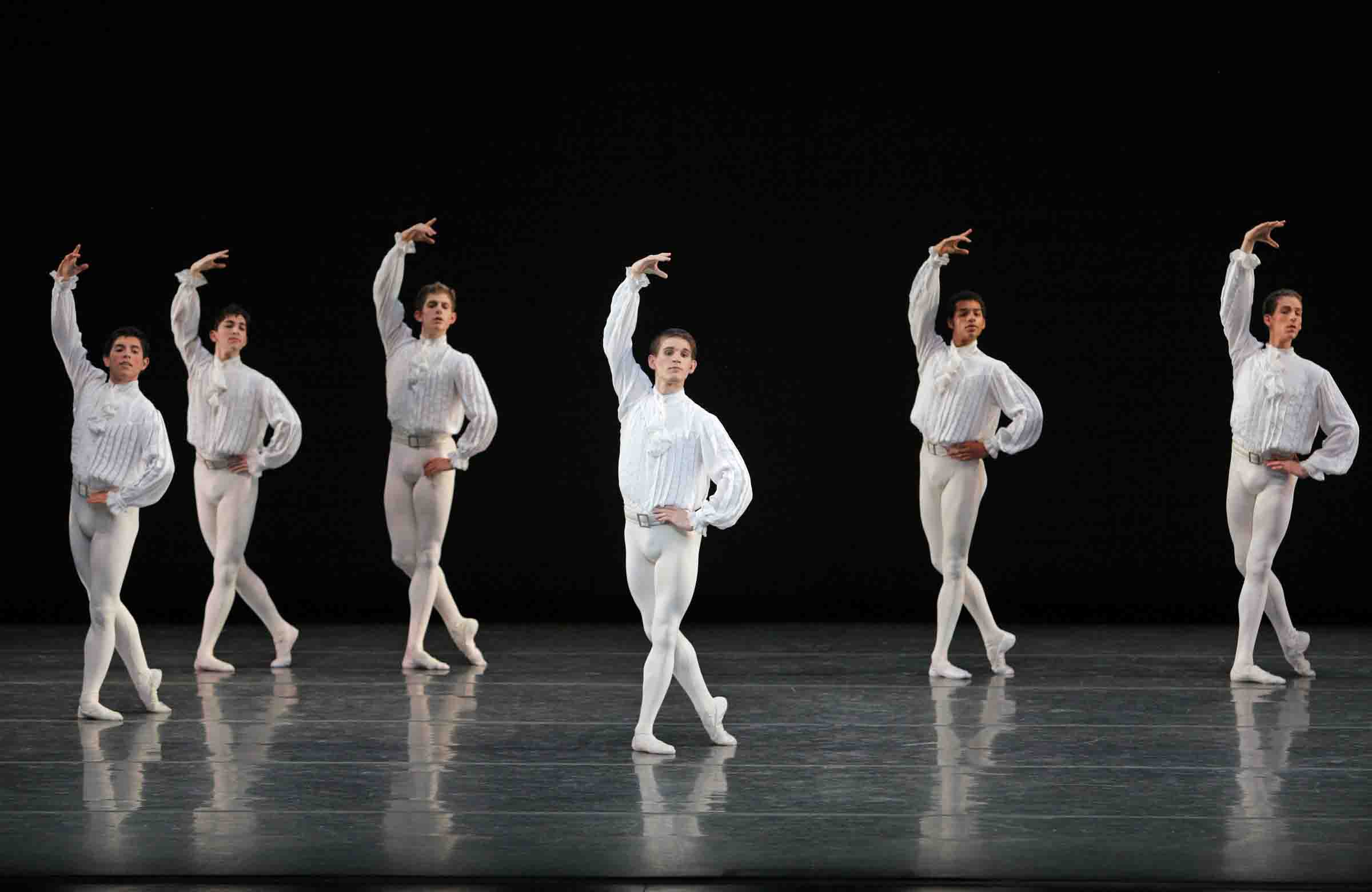This article originally appeared in Voice of Dance (http://www.voiceofdance.org) on June 5, 2007.
School of American Ballet’s 2007 Workshop Performances / Peter Jay Sharp Theater, Lincoln Center, NYC / June 2 & 4, 2007

School of American Ballet in George Balanchine’s The Four Temperaments with Raina Gilliland (foreground). Photo by Paul Kolnik.
As the entire classical dance world surely knows, the School of American Ballet’s annual Workshop Performances show the public the high-powered training that provides carefully selected young candidates to the New York City Ballet as well as companies worldwide. This year’s three performances–I saw the two on June 2, matinee and evening, with many alternations in both major and minor roles–were dedicated to Lincoln Kirstein. The occasion was the 100th anniversary of the birth of man who brought George Balanchine to America, co-founded the now-illustrious academy with him, and masterminded the companies that evolved into the New York City Ballet.
To open the program, SAB faculty member Sean Lavery revived his brief, unpretentious, and endearing suite, Twinkliana, for the school’s younger children. The silly title (a riff, of course, on Balanchine’s Mozartiana) comes from the fact that it’s set to Mozart’s Variations on “Ah, vous dirais-je, maman,” to which English speakers sing “Twinkle, twinkle, little star.”
A half dozen lithe little girls and a boy who’s something of a prodigy display the extraordinary technical capabilities of their generation, most effectively in mini-solos. The choreography is no more than capable; the wonder of its performance is the way Lavery has the youngsters dance–gently and joyously, buoyed by the music. Even the backdrop contributes to the lovely tone of the dance, a still-dark sky brushed with a faint scattering of stars.
Peter Martins’s 1987 Les Gentilhommes, for nine men dancing to Handel concerti, provided a showcase for the academy’s late-adolescent male contingent, which goes from strength to strength. The ballet seems to reach back from the 18th-century era of its music to the Renaissance cavaliers who were deft fencers, equestrians, and poets alike. All this, and the flawless manners of the gentlemen, is conveyed in the purest classical style, as befits a ballet dedicated to Stanley Williams, the celebrated SAB teacher from Denmark who bred dancers to his impeccable standards.

School of American Ballet in Peter Martins’ Les Gentilhommes led by Matthew Renko (center). Photo by Paul Kolnik.
A late addition to the program was the balcony scene from Martins’s new Romeo + Juliet, featuring Callie Bachman. When Martins created the work for the NYCB, he shaped the heroine’s role on the sixteen-year-old, intending her to dance the premiere of the piece. An injury kept her from doing so; performing this excerpt from it now that she’s healed was her consolation prize. I’m glad that Bachman got the moment in the sun that she deserves, but I don’t see in her what the publicity hoopla surrounding her performance wants me to see. She is a sweet young thing (straight out of a Boucher painting) with terrific technical prowess. Yet, being a little too conscious of her own abilities and charms, she’s not very convincing as a girl swept away by a first passion. Her partner was Russell Janzen, who gave the job his best effort.
Balanchine was represented on the program by The Four Temperaments, a landmark work, and Gounod Symphony, a candy box affair with intermittent flashes of genius. The ballets were staged by veteran custodians of the master’s repertoire, Suki Schorer and Susan Pilarre, respectively. As often happens, these women, given their own talent, a generous rehearsal period, and the eagerness of their young protégés, shaped productions that had more force and personality than the NYCB’s own versions.
Created in 1946, The Four Temperaments still looks amazingly new and its impact is stunning. In Schorer’s superb staging, full-blooded and propelled by rhythmic vitality, the piece was the program’s heart and anchor. Why Schorer doesn’t extend her gifts to the main company and why the Workshop programs that feature her skills aren’t toured are just two of the mysteries of the dancing life.
Gounod Symphony, by contrast, is pretty and fluffy and pink. Very pink, thanks to Karinska’s tutus, where layers of rosy and yellow tulle create a sunrise glow. The ballet hasn’t a moment of darkness or doubt. Balanchine amuses himself creating dozens of ways in which lines of dancers can interweave, then challenges the main couple of this pastoral matrix with inventions of highly sophisticated urbanity. Pilarre has coached her pupils to handle these features with aplomb. She might have added just a whiff of perfume.
Among this year’s raft of gifted dancers displaying almost uncanny technical acumen, Raina Gilliland and Samuel Greenberg were distinguished for a stage maturity way beyond their years. Tall, elegantly built, and beautiful–like her elder sister, Kaitlyn, already notable in the NYCB corps–the 17-year-old Raina led the Choleric section of The Four Temperaments with goddess-like power. Both Gillilands are third-generation members of a distinguished dance family. The late Loyce Houlton, founder of the Minnesota Dance Theater, was their grandmother; their mother, Lise Houlton, was a soloist with American Ballet Theatre.
Greenberg, 18, hasn’t (yet) achieved leading-man status but was outstanding in the eight-member ensemble of Les Gentilhommes and the first theme of The Four Temperaments. He already projects an adult dignity and depth of feeling that recalls the unforgettable Francisco Moncion, a charter member of the NYCB.
Best of all, perhaps, was the feeling of camaraderie in the program’s ensemble dancing. In Les Gentilhommes and Gounod Symphony especially, all the corps members seemed to delight in belonging to the same team and this made the ballets radiant.
© VoiceofDance.com 2007. Reprinted with permission.



